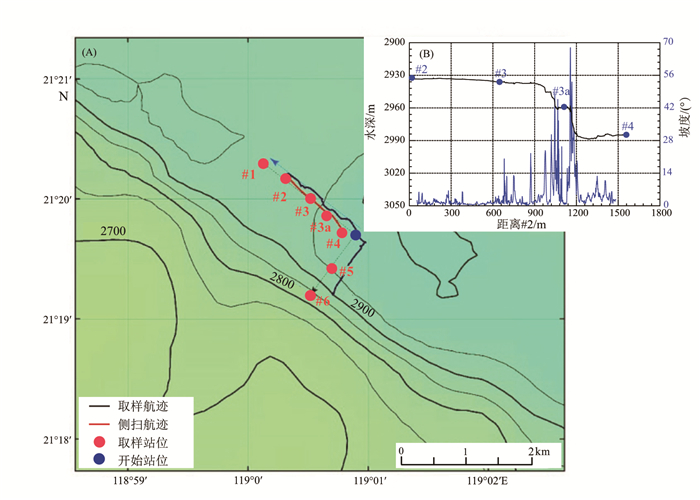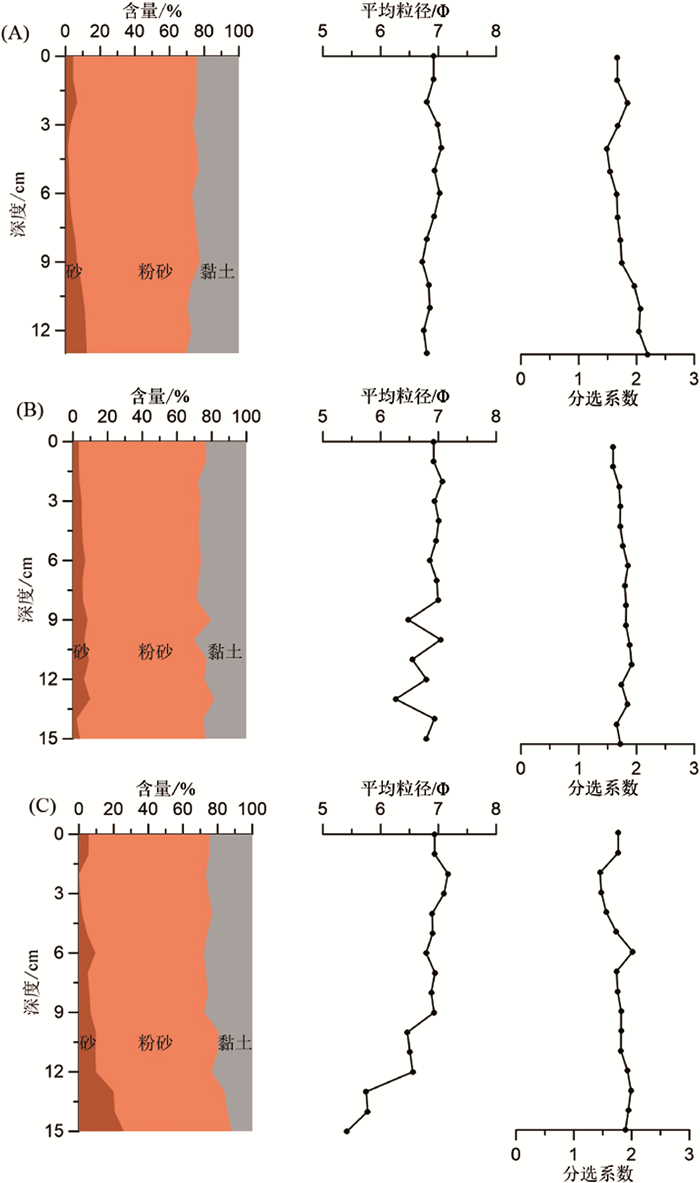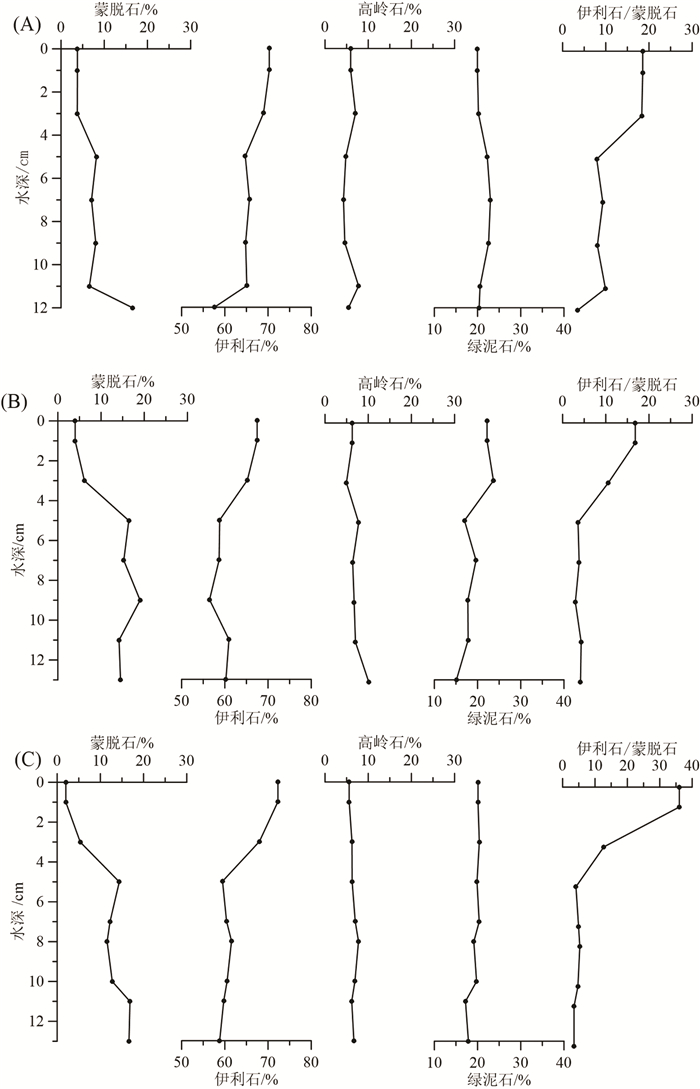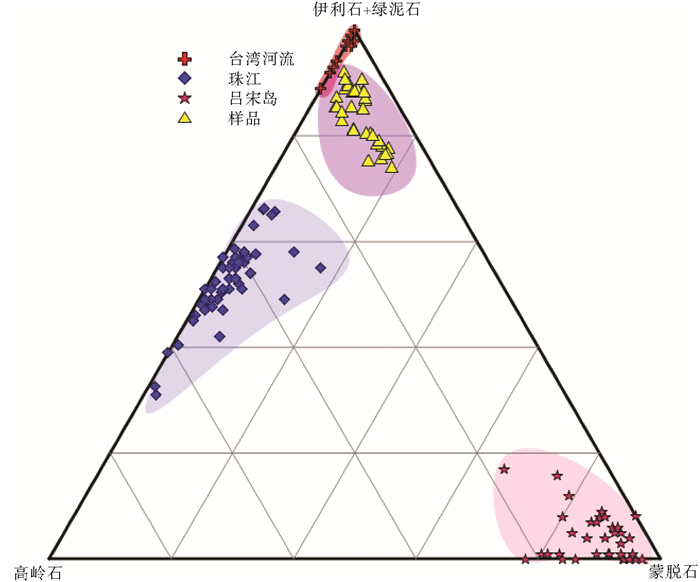Sedimentary characteristics and processes revealed by the push cores of the 140th dive of DSV "Jiaolong" in the Taiwan Submarine Canyon, Northern South China Sea
-
摘要:
海底峡谷沉积物来源、输运机制和沉积过程的研究一直是深水沉积体系研究的关键,也是近年来深海浊流沉积研究中的热点问题。对“蛟龙号”第140潜次在南海北部台湾峡谷中段3个站位获取的沉积物短柱的粒度、有孔虫和黏土矿物进行综合分析,结果表明3个短柱上部均以粒度较细、变化较小并含半深海—深海环境的底栖有孔虫为特征的半深海沉积,下部以粒度明显变粗、含有较多浅水种底栖有孔虫的浊流沉积为主。AMS14C测年结果显示该浊流沉积形成于约150aBP,表明台湾峡谷中段有典型的近现代浊流活动。此外,黏土矿物组成表明研究区正常半深海沉积与浊流沉积物源主要来自台湾,其次为珠江和吕宋岛的碎屑沉积物。
Abstract:Transportation and deposition of sediments in submarine canyons are critical for understanding the deep-sea processes and environments, particularly the turbidity currents. In this paper, three push cores, collected from three sites in the middle reaches of the Taiwan Submarine Canyon during the 140th dive of Chinese DSV (Deep Submersible Vehicle) "Jiao Long", are analyzed for sediment characteristics, sources, and depositional processes. The upper parts of the push cores are dominated by homogeneous fine-grained sediments signified by a typical hemipelagic-pelagic benthic foraminifera assemblage. In contrast, the lower parts consist of coarse-grained sediments and assemblages of "shallow-water" benthic foraminifera typically occur in coastal or shelf areas. Their depositional characteristics suggest a down-slope transportation most likely by turbidity currents along the canyon. AMS14C dating indicates that the turbidite was formed approximately 150 cal.aBP, and the clay mineral compositions suggests a kind of hemipelagic-pelagic and the turbidite deposits with sediment sources dominantly from the Taiwan island and partly from the Pearl River and Luzon Island.
-
Key words:
- sedimentary processes /
- turbidity currents /
- DSV "Jiaolong" /
- Taiwan submarine canyon /
- South China Sea
-

-
表 1 台湾峡谷“蛟龙号”第140潜次短柱样品信息
Table 1. Information of the push cores collected during the 140th dive of DSV Jiaolong in the Taiwan Submarine Canyon
短柱编号 北纬(N) 东经(E) 水深/m 长度/cm #3 21°20.00′ 119°0.62′ 2935 13.0 #3a 21°19.83′ 119°0.82′ 2961 14.1 #4 21°19.64′ 119°0.98′ 2985 14.5 表 2 短柱底栖有孔虫主要特征种属含量
Table 2. Relative abundance of benthic foraminifera in the push cores
短柱 层位/cm 内陆架 外陆架 外陆架-半深海 半深海-深海 深海 外陆架-深海 1~2 15.4 7.7 19.2 26.9 30.8 #3 7~8 4.0 36.0 8.8 6.4 44.8 12~13 17.1 35.2 1.9 2.8 43.0 1~2 6.8 1.4 34.2 57.6 #3a 6~7 4.3 17.4 78.3 13~14 0.9 9.4 17.9 8.5 63.3 1~2 11.1 16.7 5.6 66.6 #4 6~7 2.6 3.8 45.9 47.7 11~12 7.9 35.2 3.4 3.4 50.1 13.5~14.5 8.5 31.4 3.4 56.7 内陆架主要为Elphidium advenum、Florilus scaphum、Pseudorotalia schroeteriana
外陆架主要为Bolivina robusta、Brizalina sp.、Brizalina striatula、Hanjawaia mantanensis
外陆架—半深海主要为Eggerella bradyi、Globocassidulina subglobosa、Planulina wuellerstorfi
半深海—深海主要为Bulimina aculeata、Epistominella exigua
深海主要为Rhabdammina sp.表 3 #3,#3a和#4短柱黏土矿物组成特征
Table 3. Clay mineral content of the push cores
短柱 层位/cm 蒙脱石/% 伊利石/% 高岭石/% 绿泥石/% 伊利石化学指数 伊利石结晶度/(°)Δ2θ 0~1 3.8 70.3 5.9 20.0 0.26 0.33 2~3 3.8 69.0 7.1 20.2 0.25 0.29 4~5 8.2 64.7 4.8 22.3 0.30 0.29 #3 6~7 7.1 65.7 4.3 23.0 0.32 0.29 8~9 8.0 64.8 4.6 22.6 0.20 0.30 10~11 6.6 65.1 7.8 20.6 0.27 0.28 11~12 16.6 57.6 5.5 20.4 0.29 0.28 0~1 4.0 67.5 6.3 22.2 0.29 0.29 2~3 6.1 65.2 5.0 23.7 0.27 2~3 4~5 16.4 58.8 7.8 17.0 0.28 0.29 #3a 6~7 15.3 58.7 6.4 19.6 0.28 6~7 8~9 19.0 56.5 6.8 17.8 0.29 0.32 10~11 14.2 61.0 7.1 17.8 0.27 0.30 12~13 14.5 60.3 10.1 15.1 0.27 0.32 0~1 2.0 72.3 5.6 20.1 0.29 0.30 2~3 5.3 68.0 6.2 20.4 0.29 0.29 4~5 14.4 59.5 6.3 19.9 0.29 0.30 6~7 12.2 60.4 7.0 20.4 0.26 6~7 #4 7~8 11.6 61.6 7.8 19.1 0.27 0.28 9~10 12.8 60.5 6.9 19.8 0.29 0.27 10~11 16.8 59.7 6.2 17.2 0.26 0.32 12~13 16.6 58.8 6.7 17.9 0.32 0.27 -
[1] Harris P T, Whiteway T. Global distribution of large submarine canyons: Geomorphic differences between active and passive continental margins [J]. Marine Geology, 2011, 285(1-4): 69-86. doi: 10.1016/j.margeo.2011.05.008
[2] Mchugh C M G, Damuth J E, Mountain G S. Cenozoic mass-transport facies and their correlation with relative sea-level change, New Jersey continental margin[J]. Marine Geology, 2002, 184(3): 295-334. http://www.wanfangdata.com.cn/details/detail.do?_type=perio&id=93a97b61cc82972ffac2471a8f36537f
[3] Daly R A. Origin of submarine canyons[J]. Amer. J. Sei. 5th. Ser., 1936, 31: 401-420. http://d.old.wanfangdata.com.cn/NSTLQK/10.2475-ajs.s5-31.186.401/
[4] 毛凯楠, 解习农.深水峡谷体系研究现状及其地质意义[J].地质科技情报, 2014, 33(2): 21-27. http://www.wanfangdata.com.cn/details/detail.do?_type=perio&id=dzkjqb201402004
MAO Kainan, XIE Xinong. Research reviews of submarine canyons system and its geological significance [J]. Geoloical Scinence and Technology Information, 2014, 33(2): 21-27. http://www.wanfangdata.com.cn/details/detail.do?_type=perio&id=dzkjqb201402004
[5] 徐景平.海底浊流研究百年回顾[J].中国海洋大学学报:自然科学版, 2014, 44(10): 98-105. http://d.old.wanfangdata.com.cn/Periodical/qdhydxxb201410014
XU Jingping. Turbidity current research in the past century: An overview [J]. Periodical of Ocean University of China, 2014, 44(10): 98-105. http://d.old.wanfangdata.com.cn/Periodical/qdhydxxb201410014
[6] Carter L, Milliman J D, Talling P J, et al. Near-synchronous and delayed initiation of long run-out submarine sediment flows from a record-breaking river flood, offshore Taiwan [J]. Geophysical Research Letters, 2012, 39(12): L12603. http://www.wanfangdata.com.cn/details/detail.do?_type=perio&id=552863899f083583c4c2839fc4a8f185
[7] Hsu S, Kuo J, Lo C, et al. Turbidity currents, submarine landslides and the 2006 Pingtung Earthquake off SW Taiwan[J]. Terrestrial, Atmospheric and Oceanic Sciences, 2008, 19(6):767-772. doi: 10.3319/TAO.2008.19.6.767(PT)
[8] Liu J, Wang Y, Yang R, et al. Cyclone-induced hyperpycnal turbidity currents in a submarine canyon [J]. Journal of Geophysical Research: Oceans, 2012, 117(4): C04033. http://www.wanfangdata.com.cn/details/detail.do?_type=perio&id=c3a8a10fb7a1d126f09f194ff50ed464
[9] 蔡学林, 朱介寿, 曹家敏, 等.东亚西太平洋巨型裂谷体系岩石圈与软流圈结构及动力学[J].中国地质, 2002, 29(3): 234-245. doi: 10.3969/j.issn.1000-3657.2002.03.002
CAI Xuelin, ZHU Jieshou, CAO Jiamin, et al. Structure and dynamics of lithosphere and asthenosphere in the gigantic East Asian-West Pacific rift system[J]. Geology in China, 2002, 29(3): 234-245. doi: 10.3969/j.issn.1000-3657.2002.03.002
[10] Shao L, Qiao P, Pang X, et al. Nd isotopic variations and its implications in the recent sediments from the northern South China Sea[J]. Science Bulletin, 2009, 54(2): 311-317. doi: 10.1007/s11434-008-0453-8
[11] Kuang Z, Zhong G, Wang L, et al. Channel-related sediment waves on the eastern slope offshore Dongsha Islands, northern South China Sea[J]. Journal of Asian Earth Sciences, 2014, 79: 540-551. doi: 10.1016/j.jseaes.2012.09.025
[12] Zhong G, Matthieu J B, Kang Z, et al. Cyclic steps along the South Taiwan Shoal and West Penghu submarine canyons on the northeastern continental slope of the South China Sea[J]. Geological Society of America Bulletin, 2015, 127(5-6): 804-824. doi: 10.1130/B31003.1
[13] Gong C, Wang Y, Peng X, et al. Sediment waves on the South China Sea Slope off southwestern Taiwan: Implications for the intrusion of the Northern Pacific Deep Water into the South China Sea[J]. Marine and Petroleum Geology, 2012, 32(1): 95-109. doi: 10.1016/j.marpetgeo.2011.12.005
[14] 徐尚, 王英民, 彭学超, 等.台湾峡谷中段沉积特征及流体机制探讨[J].地质论评, 2013, 31(2): 325-330. doi: 10.3969/j.issn.0371-5736.2013.02.014
XU Shang, WANG Yingmin, PENG Xuechao, et al. Depositional elements and settings of HD13 and HD77 cores in the Taiwan Canyon[J]. Acta Sedimentologica Sinica, 2013, 31(2):325-330. doi: 10.3969/j.issn.0371-5736.2013.02.014
[15] Liu Z, Trentesaux A, Clemens S C, et al. Clay mineral assemblages in the northern South China Sea: implications for East Asian monsoon evolution over the past 2 million years[J]. Marine Geology, 2003, 201(1-3): 133-146. doi: 10.1016/S0025-3227(03)00213-5
[16] Tamburini F, Adatte T, Föllmi K, et al. Investigating the history of East Asian monsoon and climate during the last glacial-interglacial period (0~140000 years): mineralogy and geochemistry of ODP Sites 1143 and 1144, South China Sea[J]. Marine Geology, 2003, 201(1): 147-168.
[17] Wan S, Li A, Clift P D, et al. Development of the East Asian monsoon: Mineralogical and sedimentologic records in the northern South China Sea since 20 Ma[J]. Palaeogeography, Palaeoclimatology, Palaeoecology, 2007, 254(3-4): 561-582. doi: 10.1016/j.palaeo.2007.07.009
[18] Clift P, Lee J I, Clark M K, et al. Erosional response of South China to arc rifting and monsoonal strengthening; a record from the South China Sea[J]. Marine Geology, 2002, 184(3): 207-226. http://www.wanfangdata.com.cn/details/detail.do?_type=perio&id=3bd879293e1dcfe29d32184d3ae6930e
[19] Li X, Wei G, Shao L, et al. Geochemical and Nd isotopic variations in sediments of the South China Sea: a response to Cenozoic tectonism in SE Asia[J]. Earth and Planetary Science Letters, 2003, 211(3-4): 207-220. doi: 10.1016/S0012-821X(03)00229-2
[20] Wan S, Li A, Clift P D, et al. Increased contribution of terrigenous supply from Taiwan to the northern South China Sea since 3Ma[J]. Marine Geology, 2010, 278(1-4): 115-121. doi: 10.1016/j.margeo.2010.09.008
[21] Xu K, Milliman J D, Li A, et al. Yangtze- and Taiwan-derived sediments on the inner shelf of East China Sea[J]. Continental Shelf Research, 2009, 29(18): 2240-2256. doi: 10.1016/j.csr.2009.08.017
[22] Boulay S, Colin C, Trentesaux A, et al. Sediment sources and East Asian monsoon intensity over the last 450 ky: Mineralogical and geochemical investigations on South China Sea sediments [J]. Palaeogeography, Palaeoclimatology, Palaeoecology, 2005, 228(3): 260-277.
[23] Liu Z, Tuo S, Colin C, et al. Detrital fine-grained sediment contribution from Taiwan to the northern South China Sea and its relation to regional ocean circulation[J]. Marine Geology, 2008, 255(3-4): 149-155. doi: 10.1016/j.margeo.2008.08.003
[24] Shao L, Li X, Wei G, et al. Provenance of a prominent sediment drift on the northern slope of the South China Sea[J]. Science in China (Series D), 2001, 10(44): 919-925. http://d.wanfangdata.com.cn/Periodical_zgkx-ed200110008.aspx
[25] Wehausen R, Brumsack H. Astronomical forcing of the East Asian monsoon mirrored by the composition of Pliocene South China Sea sediments[J]. Earth and Planetary Science Letters, 2002, 201(3): 621-636. http://www.wanfangdata.com.cn/details/detail.do?_type=perio&id=687bd0468fd21d647fb1dfcaaa50b248
[26] 丁巍伟, 李家彪, 李军.南海北部陆坡海底峡谷形成机制探讨[J].海洋学研究, 2010, 28(1): 96-105. http://d.old.wanfangdata.com.cn/Periodical/dhhy201001004
DING Weiwei, LI Jiabiao, LI Jun, et al. Geomorphology, grain-size charicteristics, matter source and forming mechanism of sediment waves on the ocean bottom of the northeast South China Sea[J]. Journal of Marine Sciences, 2010, 28(1): 96-105. http://d.old.wanfangdata.com.cn/Periodical/dhhy201001004
[27] Mac Manus J. Grain size determination and interpretation[J]. Techniques in Sedimentology, 1988: 63-85. http://d.old.wanfangdata.com.cn/NSTLQK/NSTL_QKJJ0227211167/
[28] 汪品先, 章纪军, 赵泉鸿, 等.东海底质中的有孔虫与介形虫[M].北京:海洋出版社, 1988.
WANG Pinxian, ZHANG Jijun, ZHAO Quanhong, et al. Foraminifera and Ostracoda in the Sediments of East China Sea[M]. Beijing: Ocean Press, 1988.
[29] 汪品先, 闵秋宝, 卞云华.南黄海西北部底质中有孔虫、介形虫分布规律及其地质意义[C]//海洋微体古生物论文集.北京: 海洋出版社, 1980.
WANGA Pinxian, MIN Qiubao, BIAN Yunhua. Papers on Marine Micropaleontology[C]. Beijing: Ocean Press, 1980.
[30] 郑守仪.东海的胶结和瓷质有孔虫[M].北京:科学出版社, 1986.
ZHENG Shouyi. Cement and Porcellaneous Foraminifera in the East China Sea[M]. Beijing: Science Press, 1988.
[31] Murray J. Ecology and Applications of Benthic Foraminifera[M]. Cambridge University Press, Cambridge, 2006.
[32] 袁迎如.冲绳海槽的浊流沉积物[J].地质论评, 1987, 33(6): 499-505. doi: 10.3321/j.issn:0371-5736.1987.06.001
YUAN Yingru. Turbidites in the Okinawa Trough[J]. Geological Review, 1987, 33(6): 499-505. doi: 10.3321/j.issn:0371-5736.1987.06.001
[33] Liu Z, Colin C, Huang W, et al. Climatic and tectonic controls on weathering in south China and Indochina Peninsula: Clay mineralogical and geochemical investigations from the Pearl, Red, and Mekong drainage basins[J]. Geochemistry, Geophysics, Geosystems, 2007, 8(5):938-949.
[34] Liu Z, Colin C, Li X, et al. Clay mineral distribution in surface sediments of the northeastern South China Sea and surrounding fluvial drainage basins: Source and transport[J]. Marine Geology, 2010, 277(1-4): 48-60. doi: 10.1016/j.margeo.2010.08.010
[35] Liu J, Yan W, Chen Z, et al. Sediment sources and their contribution along northern coast of the South China Sea: Evidence from clay minerals of surface sediments[J]. Continental Shelf Research, 2012, 47: 156-164. doi: 10.1016/j.csr.2012.07.013
[36] Liu Z, Zhao Y, Colin C, et al. Source-to-sink transport processes of fluvial sediments in the South China Sea[J]. Earth-Science Reviews, 2016, 153: 238-273. doi: 10.1016/j.earscirev.2015.08.005
[37] Liu Z, Zhao Y, Colin C, et al. Chemical weathering in Luzon, Philippines from clay mineralogy and major-element geochemistry of river sediments[J]. Applied Geochemistry, 2009, 24(11): 2195-2205. doi: 10.1016/j.apgeochem.2009.09.025
-



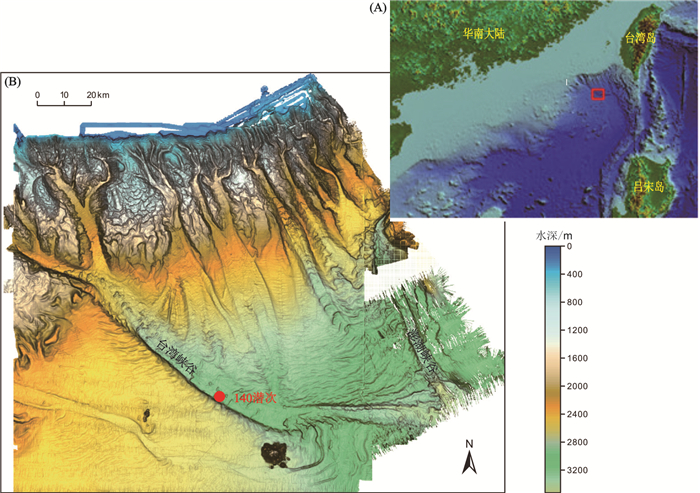
 下载:
下载:
